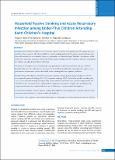Please use this identifier to cite or link to this item:
https://hdl.handle.net/20.500.14356/1869Full metadata record
| DC Field | Value | Language |
|---|---|---|
| dc.contributor.author | Thapa, P | - |
| dc.contributor.author | Basel, P | - |
| dc.contributor.author | Shrestha, I B | - |
| dc.contributor.author | Adhikari, N | - |
| dc.contributor.author | Wagle, R R | - |
| dc.contributor.author | Amatya, A | - |
| dc.date.accessioned | 2023-05-28T07:51:36Z | - |
| dc.date.available | 2023-05-28T07:51:36Z | - |
| dc.date.issued | 2013 | - |
| dc.identifier.citation | ThapaP., BaselP., ShresthaI. B., AdhikariN., WagleR. R., & AmatyaA. (2014). Household Passive Smoking and Acute Respiratory Infection among Under-Five Children Attending Kanti Children’s Hospital. Journal of Nepal Health Research Council. https://doi.org/10.33314/jnhrc.v0i0.399 | en_US |
| dc.identifier.issn | Print ISSN: 1727-5482; Online ISSN: 1999-6217 | - |
| dc.identifier.uri | http://103.69.126.140:8080/handle/20.500.14356/1869 | - |
| dc.description | Original Article | en_US |
| dc.description.abstract | Abstract Background: Worldwide, children are more heavily exposed to passive smoking than any other age group where majority of these occur in child’s house. Children's passive smoking and risk of developing respiratory diseases has been well established in several studies. However, such studies are limited in Nepal. Therefore, the objective of this study was to determine association between household passive smoking and acute respiratory infection among under five children attending Kanti Children’s Hospital. Methods: A descriptive, cross-sectional study using quantitative method was carried out in Kanti Children’s Hospital. Data was collected by face-to-face interview from 198 parents. Bivariate and multivariate analyses were performed to see association between household passive smoking and acute respiratory infection. Results: Among 198 children, 79(39.9%)were passive smokers. Among the total passive smokers, 31(39.2%) were exposed to paternal smoking, 18(22.8%) to parental smoking, 18(22.8%) to other member’s smoking and 12(15.2%) to maternal smoking. Among 36 daily passive smokers, 18(50.0%) were exposed to high amount and 18(50.0%) to low amount of passive smoking. Household passive smoking had a slight risk of developing acute respiratory infection where adjusted odds ratio was 1.35;however it was not statistically significant. Conclusions: Children exposed to passive smoking had a slight risk of developing acute respiratory infection than non-passive smokers however, it was not statistically significant. Keywords: acute respiratory infection; household passive smoking; Kanti Children’s Hospital; under-five children. | en_US |
| dc.language.iso | en | en_US |
| dc.publisher | Nepal Health Research Council | en_US |
| dc.relation.ispartofseries | May-Aug, 2013;399 | - |
| dc.subject | Acute respiratory infection | en_US |
| dc.subject | Household passive smoking | en_US |
| dc.subject | Kanti Children’s Hospital | en_US |
| dc.subject | Under-five children | en_US |
| dc.title | Household Passive Smoking and Acute Respiratory Infection among Under-Five Children Attending Kanti Children’s Hospital | en_US |
| dc.type | Journal Article | en_US |
| local.journal.category | Original Article | - |
| Appears in Collections: | Vol. 11 No. 3 Issue 25 Sep - Dec, 2013 | |
Files in This Item:
| File | Description | Size | Format | |
|---|---|---|---|---|
| 399-Article Text-482-1-10-20140207.pdf | Fulltext Download | 281.62 kB | Adobe PDF |  View/Open |
Items in DSpace are protected by copyright, with all rights reserved, unless otherwise indicated.
